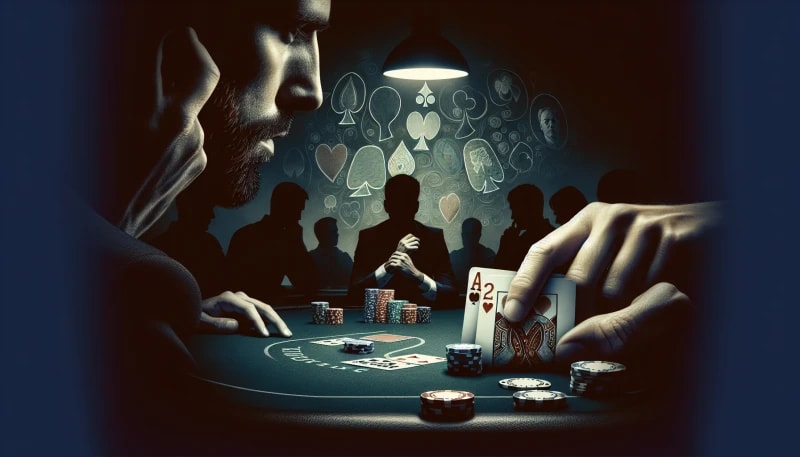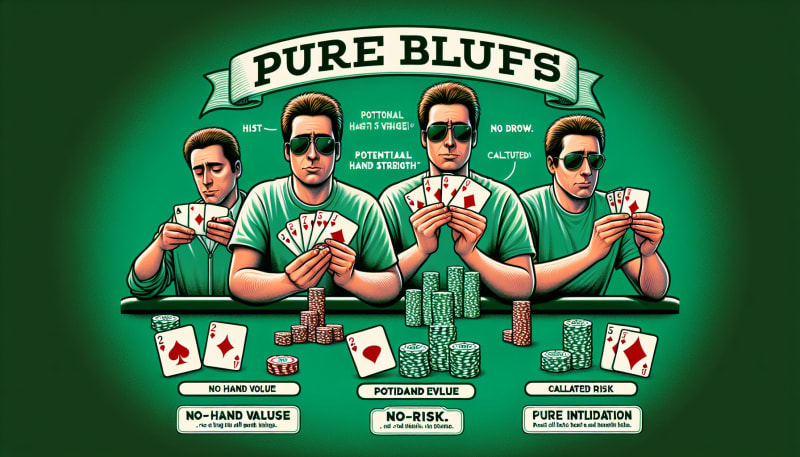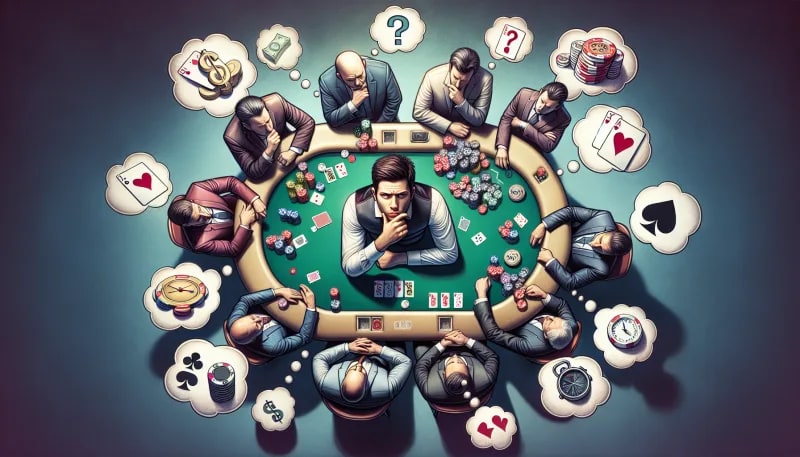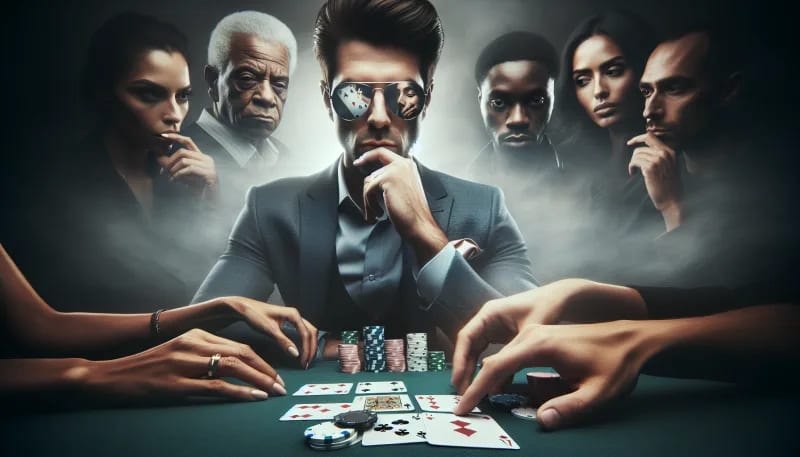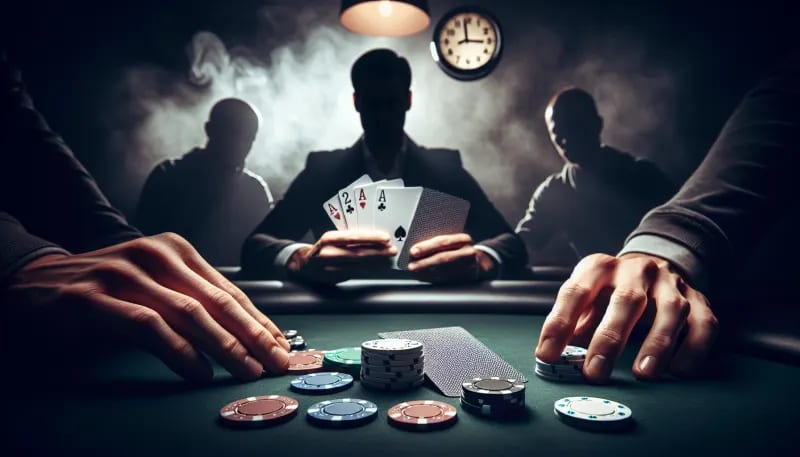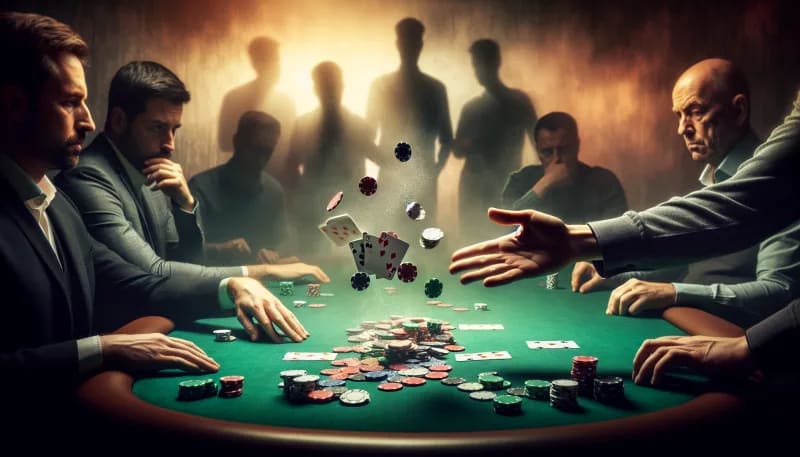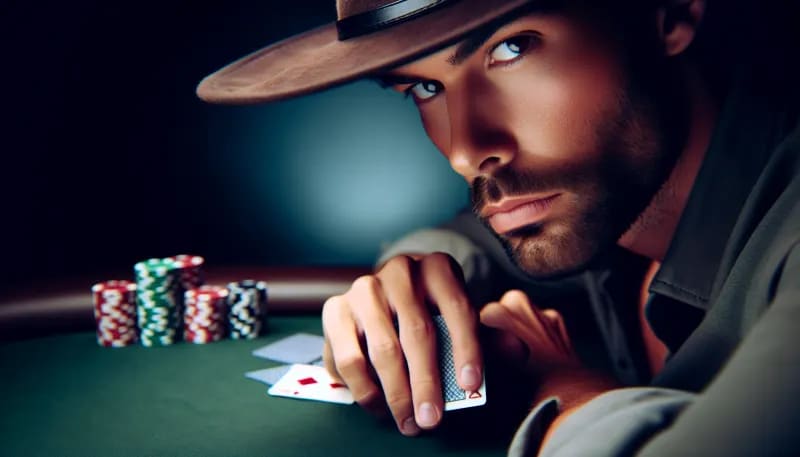Poker Bluffing 101: Mastering the Art of Deception in the Game
The Art of Deception in Poker
In poker, deception is your silent ally, a tool as vital as the cards in your hand. Ever heard of bluffing? It's not just a trick; it’s a calculated tactic. Think of it as strategic misinformation. Why play fair when you can lead your opponents down the garden path?
Bluffing isn't just about keeping a straight face. It requires a cunning blend of psychology, timing, and situational awareness. You're reading your opponents, selling a story, and all the while, heart pounding, making sure it all flies under their radar. It's the art of convincing others that your hand holds different cards than it actually does.
Imagine this: You're holding a mediocre hand. But what if you could convince everyone at the table you’ve got the nuts? That’s the magic of bluffing. And the satisfaction when it works—indescribable.
Sure, luck’s a factor. But skill? That's where bluffing becomes an art. The greatest players are those who know when to apply pressure, spot weakness, and exploit it. They weave a believable narrative through their betting patterns and table demeanor. Ever heard of a "poker face"? It’s about more than not showing emotion. It’s about projecting confidence, sometimes even false vulnerability, to manipulate the opponent’s perception.
What about the timing? Oh, it has to be impeccable. Bluff too often and you become ‘The Boy Who Cried Wolf’. Too little, and you’re just another player waiting for the perfect hand. Where’s the fun in that? A well-timed bluff can turn an otherwise inevitable loss into a surprise victory.
Remember, every hand is a story, and each bet you make adds a sentence to it. By bluffing, you’re in control of that narrative. Do you have what it takes to keep them guessing, to make them see what you want them to see?
Now, with the groundwork of bluffing laid out, let's take a step further. Understanding Bluff Types is next. We'll dive deep into the various strategies that make bluffing an art worth mastering. Ready to elevate your game?
Understanding Bluff Types
Continuing from where we delved into the art of deception in poker, it's time to break down the specific types of bluffs that can bend the perception of your table image in your favor. Each type of bluff comes with its own set of strategies and optimal situations. Let's dive into the nuance.
Pure Bluffs are the classic, high-risk, and high-reward plays that come to mind when you hear "bluffing." In these moments, I've essentially got nothing—zero hand value. But that's the point, isn't it? A pure bluff is all about convincing opponents that I'm holding a powerhouse. This move is most effective when I sense weakness in my opponents or when the table image suggests I am tight and conservative. Can they handle the pressure? I'll find out by boldly betting or raising, which can push opponents off marginal hands.
Semi-Bluffs, on the other hand, are my personal go-to. They're less about nothing and more about potential. Here, I'll bluff holding a drawing hand like a straight or flush draw. It's a clever ploy—I'm not relying solely on deception but also on actual odds. Is my opponent aware of my hidden outs? By mixing aggression with the possibility of a strong hand developing, semi-bluffs can give me two ways to win: either my opponent folds, or I hit my draw.
Then there's the Stone-Cold Bluff. It's the nuclear option. As its name suggests, it's devoid of warmth, hope, or a fallback plan. I use this when I'm confident in my read, and the board is intimidating enough to represent a threat. For example, a board of A-K-J gives me ample room to pretend I'm holding those aces or kings, especially against tight players who fear those high cards like the plague.
As we transition towards the next section, "Reading the Table: When to Bluff," remember that each bluff type isn't just a tool—it's a weapon. And in poker, the sharpness of this weapon relies heavily on the strength of your table read and timing. So, when do you think is the best moment to launch these deceptive maneuvers?
Reading the Table: When to Bluff
So, you've familiarized yourself with the various bluff types. What's next? Pinpointing the ideal moment to bluff. It's not just about the cards in your hand; it's a dance of perception and psychology.
Look around the table. What stories are the other players telling with their bets and folds? Your table image is crucial - it’s the persona you've crafted in the minds of your opponents. Have you been tight and conservative? That's your mask for the perfect bluff. If you’ve been loose and splashy, maybe it’s time to tighten up before attempting to bluff again.
Think about who you're up against. Player types matter immensely. Aggressive opponents who tend to bully might not back down from a fight. Conversely, tight players might fold too easily under pressure. Your bluff's success often hinges on their playing style.
Now, consider your position. Acting last gives you the power of information, enabling you to paint a convincing story. You’ve seen how others have bet before you; use this to your advantage. A bluff from early position is a bold move, sometimes too audacious. Are you feeling daring?
Let’s not forget the current pot size. A small pot is less tempting and therefore, less contested - perhaps an easy steal. But remember, we're artists, not robbers. Bluffing into a massive pot? That's painting on a larger canvas.
The symphony of chips clattering - isn’t it thrilling? But it's not just about sound. It's a melody of moments that screams, is this the perfect time to bluff? If you listen closely, the table talks back, echoing the sentiments of caution and opportunity.
As we segue into Spotting Tells: The Bluffing and Counter-Bluffing Game, remember that reads and bluffs go hand in hand. An understanding of tells will bolster your bluffing strategy. Consider this: every bold play you make is a brushstroke on the canvas. What picture will you paint for your opponents? Time to pick up the brush.
Spotting Tells: The Bluffing and Counter-Bluffing Game
After mastering when to bluff by reading the table, let's dive into how to pick apart your opponents' nuances for that extra edge. Remember, it's all about the details.
Do they nervously tap their chips when holding a weak hand? Or maybe they stare a bit too long at their cards when contemplating a bluff. Picking up on these subtleties can be like cracking a secret code. Observation is your best friend.
I make mental notes on each player. Steve squints when he's unsure. Linda plays with her ring when she's bluffing. It's not foolproof, but knowledge is power, right? Utilize these tells to adjust your decision-making. If Steve squints, I might call his bet, sensing weakness.
But here's the kicker - while you’re Sherlock Holmes-ing your way through their behaviors, you need to be Houdini with your own reactions. Maintain that poker face. I always keep my movements consistent, win or lose; it's a pattern that reveals nothing. Can you do the same?
Now, don't forget to mix it up. If your opponents suspect you've latched onto their tells, they might switch things up. Be ready to adapt. Sometimes, I pretend to fall for a false tell, just to keep them guessing.
Incorporate this knowledge into your bluffing strategy. If Linda's playing with her ring, I might bluff, nudging her towards folding. It's a delicate dance of deception and perception.
As we segue towards Bluffing Frequency and Bankroll Management, bear in mind that exploiting tells should align with your bankroll strategy. Overbluffing? That's a quick road to busting out. But hit that sweet spot of bluffing and counter-bluffing? You just might be stacking chips all night.
So, have I piqued your curiosity? How will you turn tells into your tactical advantage? Remember, it's not just about the cards. It's about playing the player.
Bluffing Frequency and Bankroll Management
As we peel away from the realm of spotting tells, the subtlety of art meets the precision of science in the world of bluffing. Ever wonder why some players seem to get away with bluffs more often than others? It boils down to frequency. You can't be a one-trick pony at the table; it's about striking that sweet spot where you're neither too predictable nor overly erratic. Bluff too often, and you're an open book; too little, and you're leaving money on the felt.
When it comes to frequency, balance is key. Ask yourself, are you keeping your opponents on their toes? A well-timed bluff can turn a mediocre hand into a pot winner, but only if your table image supports the narrative.
Now, let's shift gears to something just as crucial - bankroll management. It's the safety net that catches you when the bluffs go south. Effective bankroll management and bluffing proficiency are two sides of the same coin; one cannot exist without the other for long-term success. A good bluff can fill your bankroll, but a bad one can just as quickly deplete it. So, ask yourself, how deep are your pockets and are you bluffing within your means?
The golden rule here is never bluff more than you can afford to lose. Ensure each bluff is calculated within the context of your overall bankroll. This approach not only cushions the impact of a potential loss but also empowers you to bluff with conviction, which is often the difference between a fold and a call.
The symbiosis between bluff frequency and bankroll management creates a resilient poker strategy. Maintain unpredictability, stay within your limits, and you might just outlast and outplay your competition.
As we segue into the next section on ‘Common Bluffing Mistakes,’ keep in mind the delicacy of this balance. Too much salt spoils the broth, and in poker, too much bluffing spoils the bankroll. Let's make sure your tactics don’t become your downfall.
Common Bluffing Mistakes
Just as we've discussed the balance between bluffing frequency and managing your stack, there's also a skill in knowing when and against whom to bluff. I can't count the times I've seen players crash out by misstepping here. Let's break down these bluffs gone bad.
First up, bluffing too often. Ever heard of the boy who cried wolf? If you bluff too much, your table image will scream untrustworthy. Opponents will start calling you down with weaker hands. Keep asking yourself: Is my image clean enough to make this bluff credible?
Next, choosing the wrong opponents to bluff can be your undoing. Ever tried to bluff a calling station? I have, and it's like trying to dry off while jumping in a pool. It just won't work. They call with everything. Pick your targets wisely—bluff those who have shown the capacity to fold.
Then, there's the error of misreading the board texture. You put out a scare card bluff on a flop of 2-7-9, rainbow. Yet, what are you representing? If the board was A-K-Q, your story would be more believable. Always ask: does the board help my narrative?
Avoiding these pitfalls? It's all about balance. Don't over-bluff, but be aggressive enough to keep 'em guessing. Be selective with your targets, aiming at those savvy enough to fold. Read the board like a book you've written yourself—and make sure your bluff fits the plot.
Moving on, understanding the art of deception is crucial, and it ties directly to your mental game. Ever wonder what makes the poker face of a professional so impenetrable? Stay tuned for 'The Psychology Behind a Successful Bluff' to delve into the depths of a bluffer's mind.
The Psychology Behind a Successful Bluff
Ever wondered what goes on in the mind of a poker player executing a perfect bluff? It’s way more than just sheer luck. Success in bluffing hinges on a deep understanding of psychological warfare. See, a successful bluff isn't merely about the cards you play; it's about the story you tell.
Imagine sitting at the table. Your opponents are trying to read your every move. Confidence is key. When I bluff, I project confidence—not just in my hand, but in my entire demeanor. Think about it, would you believe someone who didn't believe in their own lie? Both your verbal and non-verbal cues must scream confidence. Otherwise, why would your opponents buy into your bold narrative?
Then there's fearlessness. Remember the common mistakes from before? Hesitation can be your downfall. To bluff effectively, I cast aside doubt. A hint of fear? That's a tell, and good players sniff it out like sharks drawn to a drop of blood in the ocean. Can you look fear in the eye and push past it? That’s what separates the winners from the rest.
One of my favorite parts of poker is the sweet manipulation—ethical, of course. Influencing opponents' decisions requires a mix of art and psychology. It's like being a puppeteer. I delicately pull the strings, nudging them towards the narrative I've created. A successful bluff ensures opponents are buying what you’re selling. They shouldn't just fold; they should feel compelled to fold.
By understanding your opponent's mindset, you exploit their weaknesses. Do they play conservatively? Flash a narrative of unquestionable strength. Are they aggressive? Bait them into a corner where their aggression backfires.
But how do you seamlessly transition from understanding these psychological principles to applying them in live gameplay? The next section – 'Putting Theory into Practice: Real-World Bluffing Scenarios’ – will guide you through this. It's where the rubber meets the road, and like I mentioned, we're not just dealing cards; we're dealing stories. Stories that win pots. Ready to craft yours?
Putting Theory into Practice: Real-World Bluffing Scenarios
In the previous section, we explored the psychological intricacies of a successful bluff. But how does one translate that knowledge into actual play?
Take the infamous Chris Moneymaker's bluff against Sam Farha in the 2003 World Series of Poker. With a risky move, Moneymaker went all-in with a mediocre hand. Farha folded a stronger hand, illustrating just how potent a well-timed psychological ploy can be. This wasn’t just luck; Moneymaker had been attentively building a table image that made his bluff believable.
Another classic scenario is Doyle Brunson’s bluff in the 1976 World Series of Poker. Known for his aggressive play, Brunson pushed a large bet on the river with nothing but ten-deuce offsuit. What's remarkable here is his understanding of his opponent’s mindset — a skill honed through practice and patience.
Considered theoretically, bluffs are about disguises. They're mind games where you convince opponents that you hold cards you don't. But you may wonder, how often should you bluff? Remember, if you bluff too little, you won’t win as many pots as you could. Bluff too much, and observant players will start calling you down.
Can you think of a recent time when you bluffed successfully? Or perhaps when you failed and learned a valuable lesson? Real-world experience is the best teacher. Every table, every hand, and every player brings a new opportunity to refine your craft.
Practice makes perfect. Start small with bluffs in low-stakes games. Notice how players react. Learn from their patterns. Be patient with yourself; bluffing is an art as much as it is a skill. It takes time to develop the intuition needed to make those daring moves.
Encourage yourself to step out of your comfort zone. Next time you're on the felt, consider the situation carefully. Is this a good time to bluff? Will the story you’ve been telling throughout the hand support it? When the moment feels right, trust your gut and make the play.
Mastering the skill of bluffing can be the difference between a good poker player and a great one. Keep practicing, stay patient, and watch how your game transforms.

